How Business Operates: UK Organisations, PESTLE, and HR Functions
VerifiedAdded on 2020/11/12
|16
|3903
|448
Report
AI Summary
This report provides a comprehensive overview of business operations in the UK, covering various aspects of public and private organizations. It begins with a description of different organizational types, including sole traders, partnerships, companies, franchising, and government organizations. The report then delves into organizational structures, examining flat, matrix, and hierarchical structures with examples. A significant portion is dedicated to a PESTLE analysis of Tesco Ltd., evaluating the political, economic, social, technological, environmental, and legal factors impacting the company. Furthermore, the report explores the functions of the HR department, including hiring, training, employee benefits, employee relations, and legal responsibilities. It also outlines key employment legislation in the UK. The importance of accounting for organizations, along with profit and loss account explanations, is highlighted. The report also discusses team development stages, leadership styles, motivational theories, customer service benefits, and customer profiling. Finally, the report includes references to support the analysis.
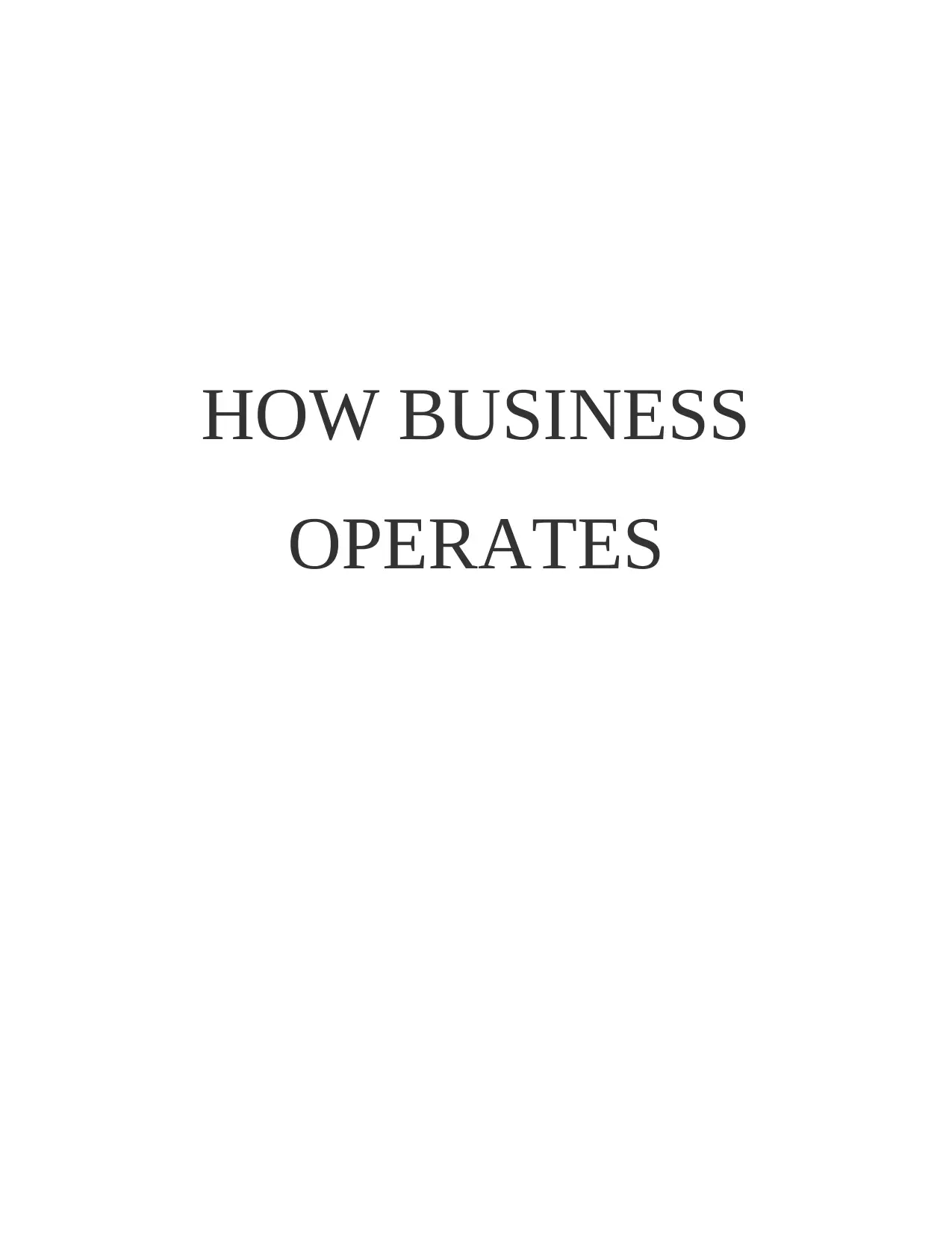
HOW BUSINESS
OPERATES
OPERATES
Paraphrase This Document
Need a fresh take? Get an instant paraphrase of this document with our AI Paraphraser
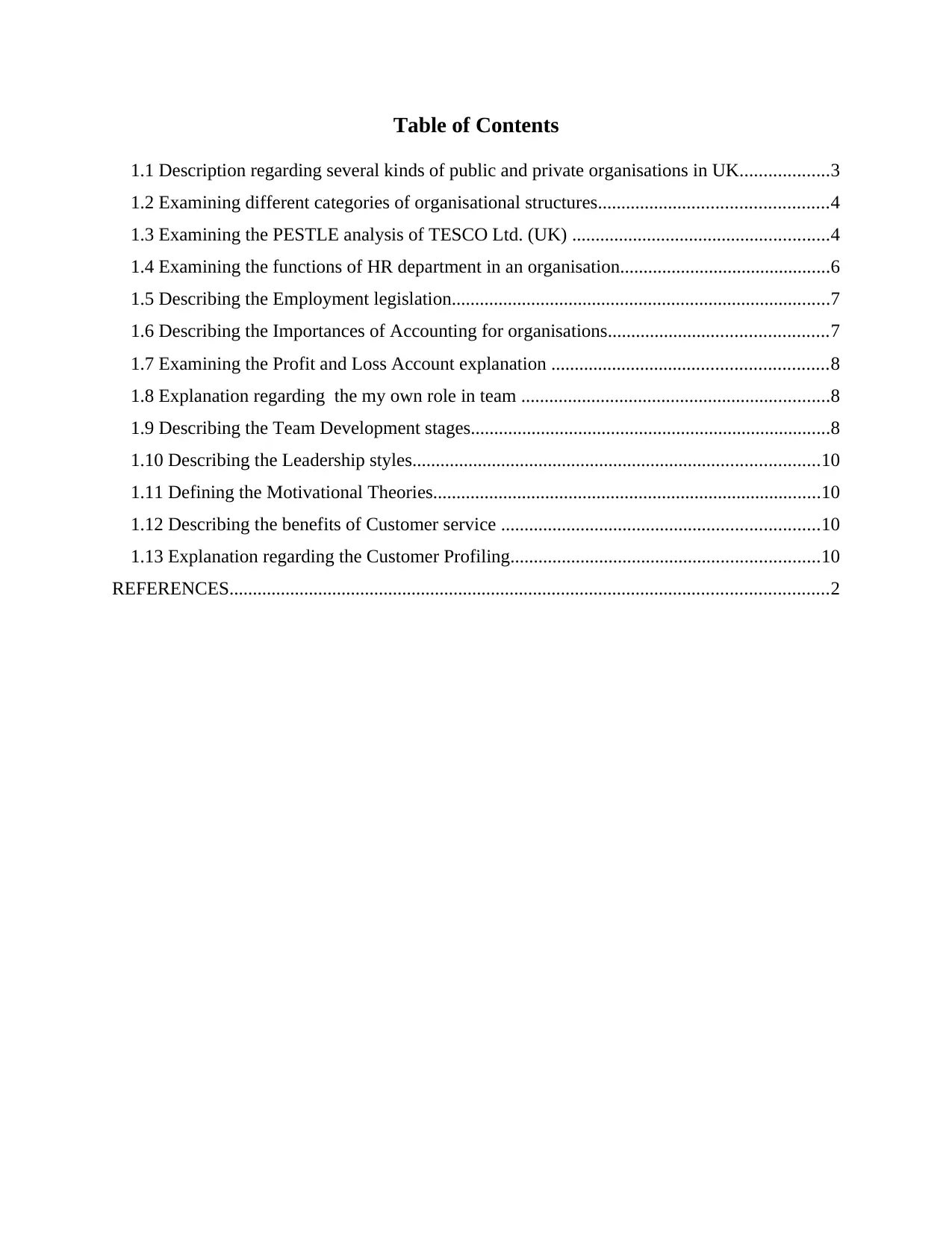
Table of Contents
1.1 Description regarding several kinds of public and private organisations in UK...................3
1.2 Examining different categories of organisational structures.................................................4
1.3 Examining the PESTLE analysis of TESCO Ltd. (UK) .......................................................4
1.4 Examining the functions of HR department in an organisation.............................................6
1.5 Describing the Employment legislation.................................................................................7
1.6 Describing the Importances of Accounting for organisations...............................................7
1.7 Examining the Profit and Loss Account explanation ...........................................................8
1.8 Explanation regarding the my own role in team ..................................................................8
1.9 Describing the Team Development stages.............................................................................8
1.10 Describing the Leadership styles.......................................................................................10
1.11 Defining the Motivational Theories...................................................................................10
1.12 Describing the benefits of Customer service ....................................................................10
1.13 Explanation regarding the Customer Profiling..................................................................10
REFERENCES................................................................................................................................2
1.1 Description regarding several kinds of public and private organisations in UK...................3
1.2 Examining different categories of organisational structures.................................................4
1.3 Examining the PESTLE analysis of TESCO Ltd. (UK) .......................................................4
1.4 Examining the functions of HR department in an organisation.............................................6
1.5 Describing the Employment legislation.................................................................................7
1.6 Describing the Importances of Accounting for organisations...............................................7
1.7 Examining the Profit and Loss Account explanation ...........................................................8
1.8 Explanation regarding the my own role in team ..................................................................8
1.9 Describing the Team Development stages.............................................................................8
1.10 Describing the Leadership styles.......................................................................................10
1.11 Defining the Motivational Theories...................................................................................10
1.12 Describing the benefits of Customer service ....................................................................10
1.13 Explanation regarding the Customer Profiling..................................................................10
REFERENCES................................................................................................................................2
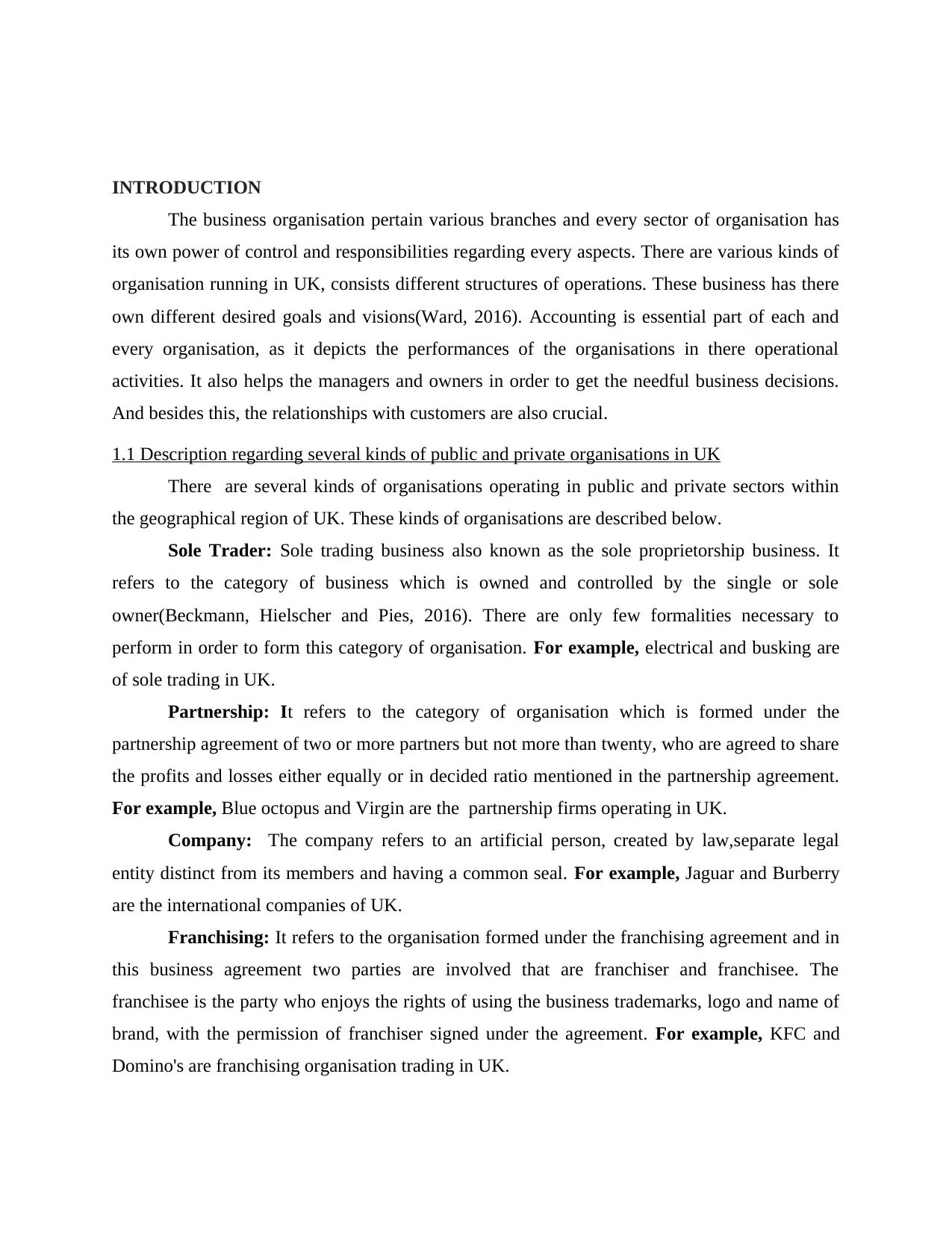
INTRODUCTION
The business organisation pertain various branches and every sector of organisation has
its own power of control and responsibilities regarding every aspects. There are various kinds of
organisation running in UK, consists different structures of operations. These business has there
own different desired goals and visions(Ward, 2016). Accounting is essential part of each and
every organisation, as it depicts the performances of the organisations in there operational
activities. It also helps the managers and owners in order to get the needful business decisions.
And besides this, the relationships with customers are also crucial.
1.1 Description regarding several kinds of public and private organisations in UK
There are several kinds of organisations operating in public and private sectors within
the geographical region of UK. These kinds of organisations are described below.
Sole Trader: Sole trading business also known as the sole proprietorship business. It
refers to the category of business which is owned and controlled by the single or sole
owner(Beckmann, Hielscher and Pies, 2016). There are only few formalities necessary to
perform in order to form this category of organisation. For example, electrical and busking are
of sole trading in UK.
Partnership: It refers to the category of organisation which is formed under the
partnership agreement of two or more partners but not more than twenty, who are agreed to share
the profits and losses either equally or in decided ratio mentioned in the partnership agreement.
For example, Blue octopus and Virgin are the partnership firms operating in UK.
Company: The company refers to an artificial person, created by law,separate legal
entity distinct from its members and having a common seal. For example, Jaguar and Burberry
are the international companies of UK.
Franchising: It refers to the organisation formed under the franchising agreement and in
this business agreement two parties are involved that are franchiser and franchisee. The
franchisee is the party who enjoys the rights of using the business trademarks, logo and name of
brand, with the permission of franchiser signed under the agreement. For example, KFC and
Domino's are franchising organisation trading in UK.
The business organisation pertain various branches and every sector of organisation has
its own power of control and responsibilities regarding every aspects. There are various kinds of
organisation running in UK, consists different structures of operations. These business has there
own different desired goals and visions(Ward, 2016). Accounting is essential part of each and
every organisation, as it depicts the performances of the organisations in there operational
activities. It also helps the managers and owners in order to get the needful business decisions.
And besides this, the relationships with customers are also crucial.
1.1 Description regarding several kinds of public and private organisations in UK
There are several kinds of organisations operating in public and private sectors within
the geographical region of UK. These kinds of organisations are described below.
Sole Trader: Sole trading business also known as the sole proprietorship business. It
refers to the category of business which is owned and controlled by the single or sole
owner(Beckmann, Hielscher and Pies, 2016). There are only few formalities necessary to
perform in order to form this category of organisation. For example, electrical and busking are
of sole trading in UK.
Partnership: It refers to the category of organisation which is formed under the
partnership agreement of two or more partners but not more than twenty, who are agreed to share
the profits and losses either equally or in decided ratio mentioned in the partnership agreement.
For example, Blue octopus and Virgin are the partnership firms operating in UK.
Company: The company refers to an artificial person, created by law,separate legal
entity distinct from its members and having a common seal. For example, Jaguar and Burberry
are the international companies of UK.
Franchising: It refers to the organisation formed under the franchising agreement and in
this business agreement two parties are involved that are franchiser and franchisee. The
franchisee is the party who enjoys the rights of using the business trademarks, logo and name of
brand, with the permission of franchiser signed under the agreement. For example, KFC and
Domino's are franchising organisation trading in UK.
⊘ This is a preview!⊘
Do you want full access?
Subscribe today to unlock all pages.

Trusted by 1+ million students worldwide
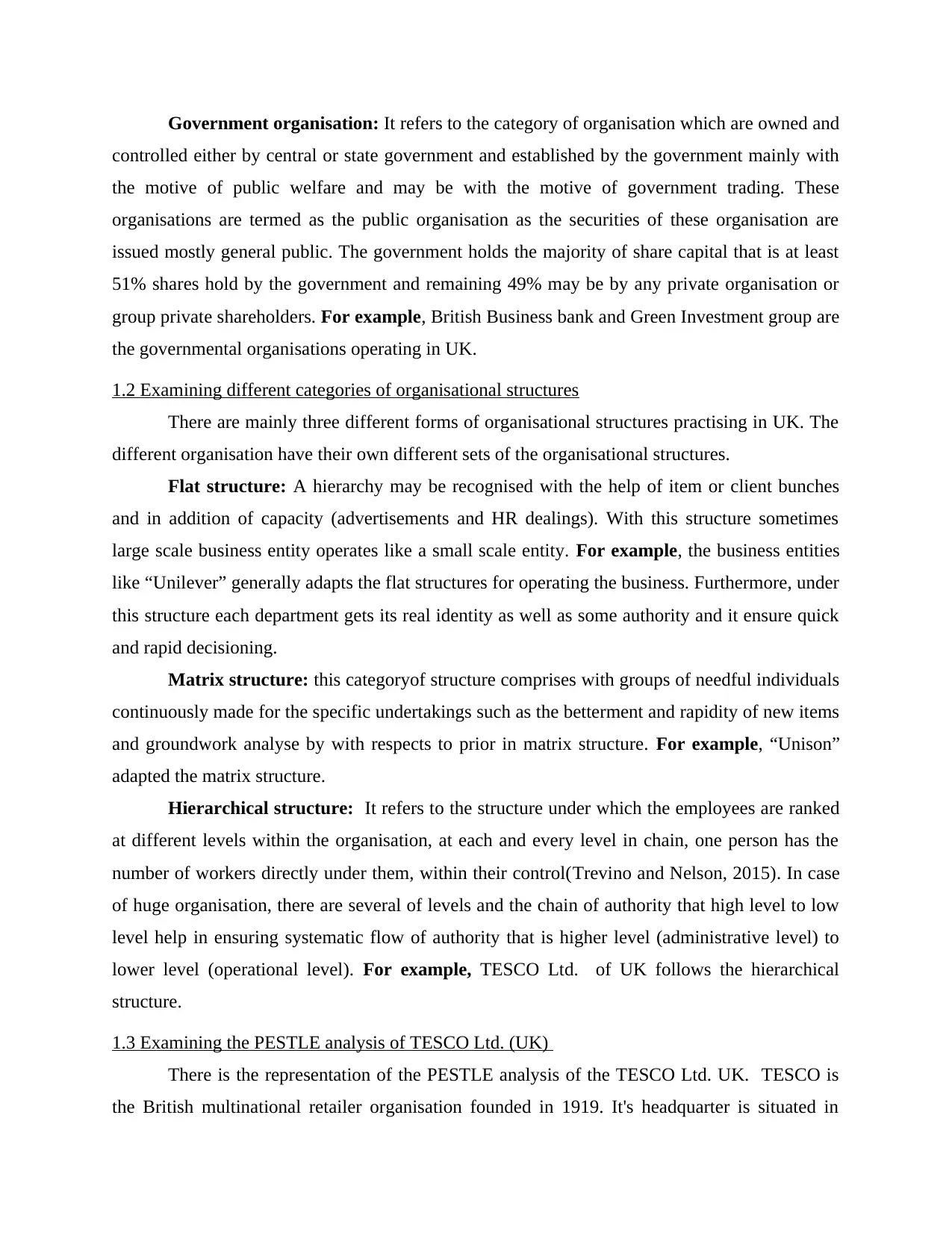
Government organisation: It refers to the category of organisation which are owned and
controlled either by central or state government and established by the government mainly with
the motive of public welfare and may be with the motive of government trading. These
organisations are termed as the public organisation as the securities of these organisation are
issued mostly general public. The government holds the majority of share capital that is at least
51% shares hold by the government and remaining 49% may be by any private organisation or
group private shareholders. For example, British Business bank and Green Investment group are
the governmental organisations operating in UK.
1.2 Examining different categories of organisational structures
There are mainly three different forms of organisational structures practising in UK. The
different organisation have their own different sets of the organisational structures.
Flat structure: A hierarchy may be recognised with the help of item or client bunches
and in addition of capacity (advertisements and HR dealings). With this structure sometimes
large scale business entity operates like a small scale entity. For example, the business entities
like “Unilever” generally adapts the flat structures for operating the business. Furthermore, under
this structure each department gets its real identity as well as some authority and it ensure quick
and rapid decisioning.
Matrix structure: this categoryof structure comprises with groups of needful individuals
continuously made for the specific undertakings such as the betterment and rapidity of new items
and groundwork analyse by with respects to prior in matrix structure. For example, “Unison”
adapted the matrix structure.
Hierarchical structure: It refers to the structure under which the employees are ranked
at different levels within the organisation, at each and every level in chain, one person has the
number of workers directly under them, within their control(Trevino and Nelson, 2015). In case
of huge organisation, there are several of levels and the chain of authority that high level to low
level help in ensuring systematic flow of authority that is higher level (administrative level) to
lower level (operational level). For example, TESCO Ltd. of UK follows the hierarchical
structure.
1.3 Examining the PESTLE analysis of TESCO Ltd. (UK)
There is the representation of the PESTLE analysis of the TESCO Ltd. UK. TESCO is
the British multinational retailer organisation founded in 1919. It's headquarter is situated in
controlled either by central or state government and established by the government mainly with
the motive of public welfare and may be with the motive of government trading. These
organisations are termed as the public organisation as the securities of these organisation are
issued mostly general public. The government holds the majority of share capital that is at least
51% shares hold by the government and remaining 49% may be by any private organisation or
group private shareholders. For example, British Business bank and Green Investment group are
the governmental organisations operating in UK.
1.2 Examining different categories of organisational structures
There are mainly three different forms of organisational structures practising in UK. The
different organisation have their own different sets of the organisational structures.
Flat structure: A hierarchy may be recognised with the help of item or client bunches
and in addition of capacity (advertisements and HR dealings). With this structure sometimes
large scale business entity operates like a small scale entity. For example, the business entities
like “Unilever” generally adapts the flat structures for operating the business. Furthermore, under
this structure each department gets its real identity as well as some authority and it ensure quick
and rapid decisioning.
Matrix structure: this categoryof structure comprises with groups of needful individuals
continuously made for the specific undertakings such as the betterment and rapidity of new items
and groundwork analyse by with respects to prior in matrix structure. For example, “Unison”
adapted the matrix structure.
Hierarchical structure: It refers to the structure under which the employees are ranked
at different levels within the organisation, at each and every level in chain, one person has the
number of workers directly under them, within their control(Trevino and Nelson, 2015). In case
of huge organisation, there are several of levels and the chain of authority that high level to low
level help in ensuring systematic flow of authority that is higher level (administrative level) to
lower level (operational level). For example, TESCO Ltd. of UK follows the hierarchical
structure.
1.3 Examining the PESTLE analysis of TESCO Ltd. (UK)
There is the representation of the PESTLE analysis of the TESCO Ltd. UK. TESCO is
the British multinational retailer organisation founded in 1919. It's headquarter is situated in
Paraphrase This Document
Need a fresh take? Get an instant paraphrase of this document with our AI Paraphraser
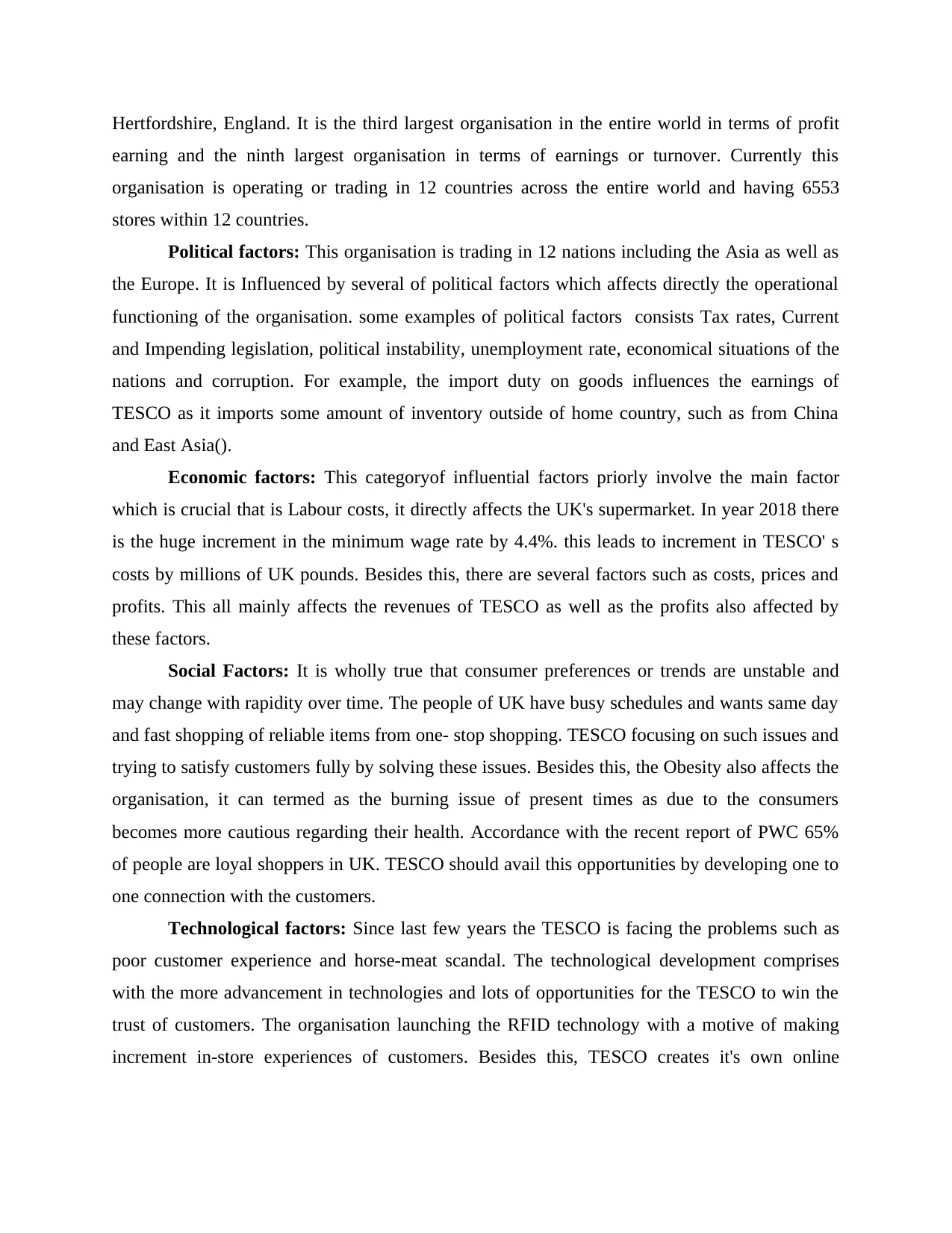
Hertfordshire, England. It is the third largest organisation in the entire world in terms of profit
earning and the ninth largest organisation in terms of earnings or turnover. Currently this
organisation is operating or trading in 12 countries across the entire world and having 6553
stores within 12 countries.
Political factors: This organisation is trading in 12 nations including the Asia as well as
the Europe. It is Influenced by several of political factors which affects directly the operational
functioning of the organisation. some examples of political factors consists Tax rates, Current
and Impending legislation, political instability, unemployment rate, economical situations of the
nations and corruption. For example, the import duty on goods influences the earnings of
TESCO as it imports some amount of inventory outside of home country, such as from China
and East Asia().
Economic factors: This categoryof influential factors priorly involve the main factor
which is crucial that is Labour costs, it directly affects the UK's supermarket. In year 2018 there
is the huge increment in the minimum wage rate by 4.4%. this leads to increment in TESCO' s
costs by millions of UK pounds. Besides this, there are several factors such as costs, prices and
profits. This all mainly affects the revenues of TESCO as well as the profits also affected by
these factors.
Social Factors: It is wholly true that consumer preferences or trends are unstable and
may change with rapidity over time. The people of UK have busy schedules and wants same day
and fast shopping of reliable items from one- stop shopping. TESCO focusing on such issues and
trying to satisfy customers fully by solving these issues. Besides this, the Obesity also affects the
organisation, it can termed as the burning issue of present times as due to the consumers
becomes more cautious regarding their health. Accordance with the recent report of PWC 65%
of people are loyal shoppers in UK. TESCO should avail this opportunities by developing one to
one connection with the customers.
Technological factors: Since last few years the TESCO is facing the problems such as
poor customer experience and horse-meat scandal. The technological development comprises
with the more advancement in technologies and lots of opportunities for the TESCO to win the
trust of customers. The organisation launching the RFID technology with a motive of making
increment in-store experiences of customers. Besides this, TESCO creates it's own online
earning and the ninth largest organisation in terms of earnings or turnover. Currently this
organisation is operating or trading in 12 countries across the entire world and having 6553
stores within 12 countries.
Political factors: This organisation is trading in 12 nations including the Asia as well as
the Europe. It is Influenced by several of political factors which affects directly the operational
functioning of the organisation. some examples of political factors consists Tax rates, Current
and Impending legislation, political instability, unemployment rate, economical situations of the
nations and corruption. For example, the import duty on goods influences the earnings of
TESCO as it imports some amount of inventory outside of home country, such as from China
and East Asia().
Economic factors: This categoryof influential factors priorly involve the main factor
which is crucial that is Labour costs, it directly affects the UK's supermarket. In year 2018 there
is the huge increment in the minimum wage rate by 4.4%. this leads to increment in TESCO' s
costs by millions of UK pounds. Besides this, there are several factors such as costs, prices and
profits. This all mainly affects the revenues of TESCO as well as the profits also affected by
these factors.
Social Factors: It is wholly true that consumer preferences or trends are unstable and
may change with rapidity over time. The people of UK have busy schedules and wants same day
and fast shopping of reliable items from one- stop shopping. TESCO focusing on such issues and
trying to satisfy customers fully by solving these issues. Besides this, the Obesity also affects the
organisation, it can termed as the burning issue of present times as due to the consumers
becomes more cautious regarding their health. Accordance with the recent report of PWC 65%
of people are loyal shoppers in UK. TESCO should avail this opportunities by developing one to
one connection with the customers.
Technological factors: Since last few years the TESCO is facing the problems such as
poor customer experience and horse-meat scandal. The technological development comprises
with the more advancement in technologies and lots of opportunities for the TESCO to win the
trust of customers. The organisation launching the RFID technology with a motive of making
increment in-store experiences of customers. Besides this, TESCO creates it's own online
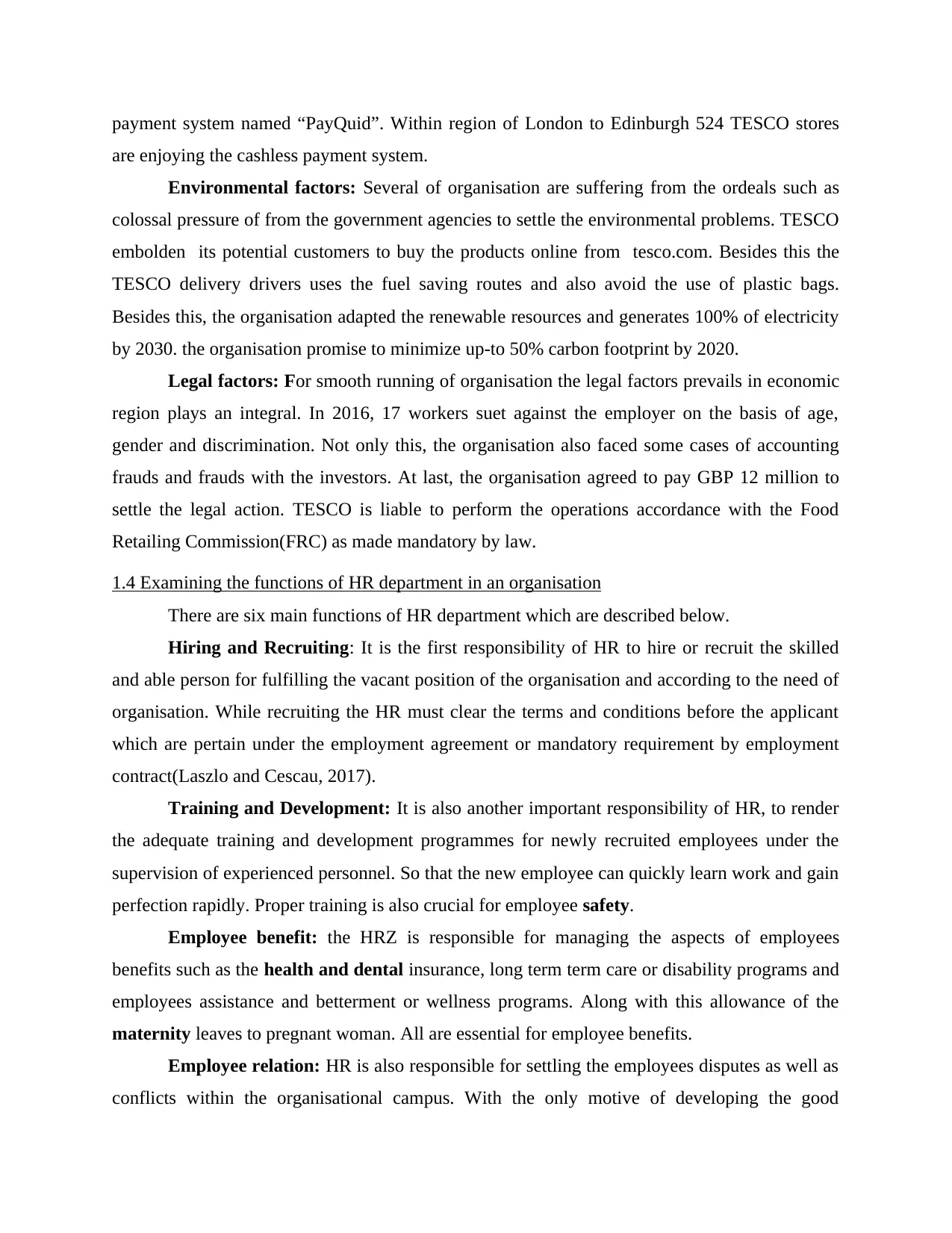
payment system named “PayQuid”. Within region of London to Edinburgh 524 TESCO stores
are enjoying the cashless payment system.
Environmental factors: Several of organisation are suffering from the ordeals such as
colossal pressure of from the government agencies to settle the environmental problems. TESCO
embolden its potential customers to buy the products online from tesco.com. Besides this the
TESCO delivery drivers uses the fuel saving routes and also avoid the use of plastic bags.
Besides this, the organisation adapted the renewable resources and generates 100% of electricity
by 2030. the organisation promise to minimize up-to 50% carbon footprint by 2020.
Legal factors: For smooth running of organisation the legal factors prevails in economic
region plays an integral. In 2016, 17 workers suet against the employer on the basis of age,
gender and discrimination. Not only this, the organisation also faced some cases of accounting
frauds and frauds with the investors. At last, the organisation agreed to pay GBP 12 million to
settle the legal action. TESCO is liable to perform the operations accordance with the Food
Retailing Commission(FRC) as made mandatory by law.
1.4 Examining the functions of HR department in an organisation
There are six main functions of HR department which are described below.
Hiring and Recruiting: It is the first responsibility of HR to hire or recruit the skilled
and able person for fulfilling the vacant position of the organisation and according to the need of
organisation. While recruiting the HR must clear the terms and conditions before the applicant
which are pertain under the employment agreement or mandatory requirement by employment
contract(Laszlo and Cescau, 2017).
Training and Development: It is also another important responsibility of HR, to render
the adequate training and development programmes for newly recruited employees under the
supervision of experienced personnel. So that the new employee can quickly learn work and gain
perfection rapidly. Proper training is also crucial for employee safety.
Employee benefit: the HRZ is responsible for managing the aspects of employees
benefits such as the health and dental insurance, long term term care or disability programs and
employees assistance and betterment or wellness programs. Along with this allowance of the
maternity leaves to pregnant woman. All are essential for employee benefits.
Employee relation: HR is also responsible for settling the employees disputes as well as
conflicts within the organisational campus. With the only motive of developing the good
are enjoying the cashless payment system.
Environmental factors: Several of organisation are suffering from the ordeals such as
colossal pressure of from the government agencies to settle the environmental problems. TESCO
embolden its potential customers to buy the products online from tesco.com. Besides this the
TESCO delivery drivers uses the fuel saving routes and also avoid the use of plastic bags.
Besides this, the organisation adapted the renewable resources and generates 100% of electricity
by 2030. the organisation promise to minimize up-to 50% carbon footprint by 2020.
Legal factors: For smooth running of organisation the legal factors prevails in economic
region plays an integral. In 2016, 17 workers suet against the employer on the basis of age,
gender and discrimination. Not only this, the organisation also faced some cases of accounting
frauds and frauds with the investors. At last, the organisation agreed to pay GBP 12 million to
settle the legal action. TESCO is liable to perform the operations accordance with the Food
Retailing Commission(FRC) as made mandatory by law.
1.4 Examining the functions of HR department in an organisation
There are six main functions of HR department which are described below.
Hiring and Recruiting: It is the first responsibility of HR to hire or recruit the skilled
and able person for fulfilling the vacant position of the organisation and according to the need of
organisation. While recruiting the HR must clear the terms and conditions before the applicant
which are pertain under the employment agreement or mandatory requirement by employment
contract(Laszlo and Cescau, 2017).
Training and Development: It is also another important responsibility of HR, to render
the adequate training and development programmes for newly recruited employees under the
supervision of experienced personnel. So that the new employee can quickly learn work and gain
perfection rapidly. Proper training is also crucial for employee safety.
Employee benefit: the HRZ is responsible for managing the aspects of employees
benefits such as the health and dental insurance, long term term care or disability programs and
employees assistance and betterment or wellness programs. Along with this allowance of the
maternity leaves to pregnant woman. All are essential for employee benefits.
Employee relation: HR is also responsible for settling the employees disputes as well as
conflicts within the organisational campus. With the only motive of developing the good
⊘ This is a preview!⊘
Do you want full access?
Subscribe today to unlock all pages.

Trusted by 1+ million students worldwide
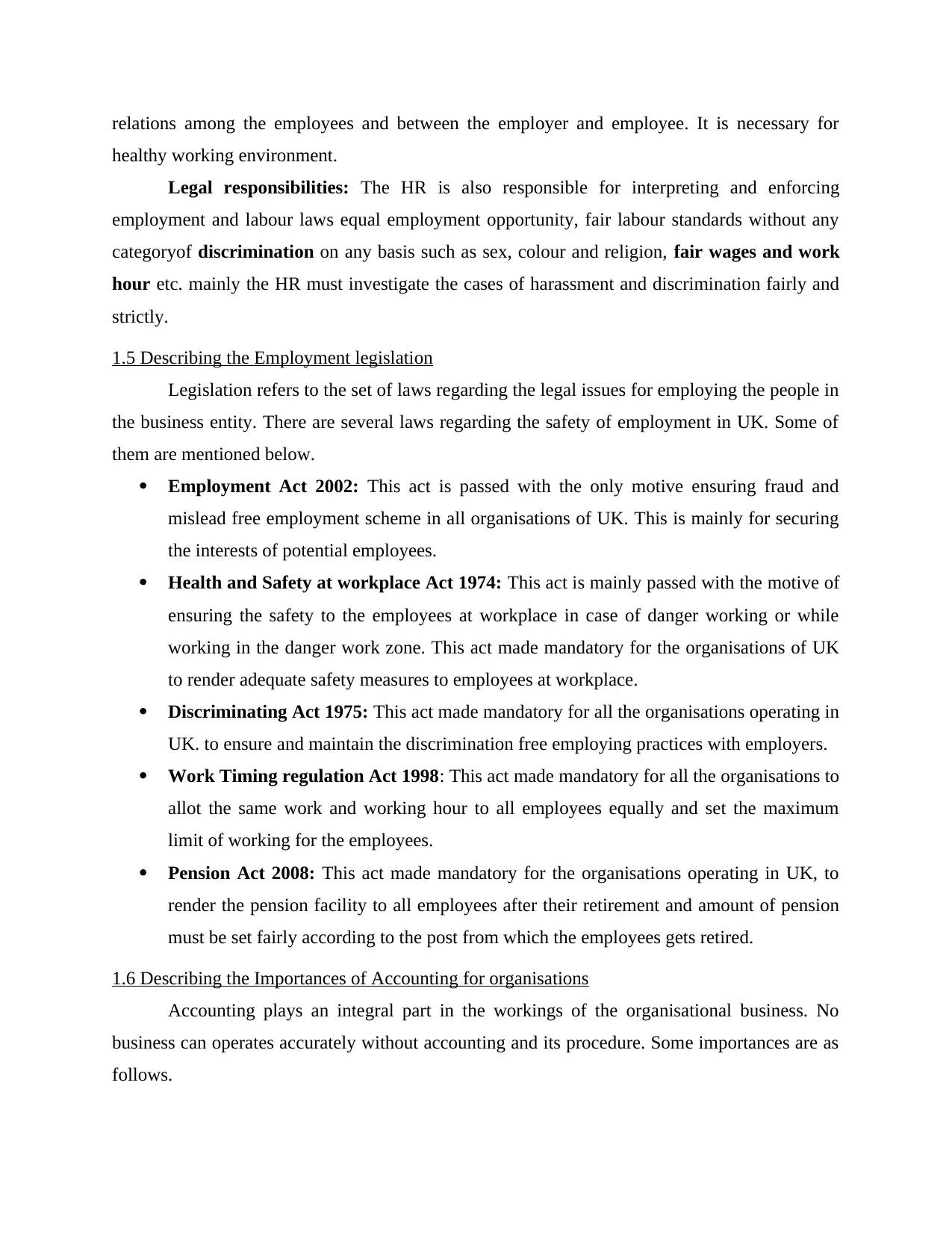
relations among the employees and between the employer and employee. It is necessary for
healthy working environment.
Legal responsibilities: The HR is also responsible for interpreting and enforcing
employment and labour laws equal employment opportunity, fair labour standards without any
categoryof discrimination on any basis such as sex, colour and religion, fair wages and work
hour etc. mainly the HR must investigate the cases of harassment and discrimination fairly and
strictly.
1.5 Describing the Employment legislation
Legislation refers to the set of laws regarding the legal issues for employing the people in
the business entity. There are several laws regarding the safety of employment in UK. Some of
them are mentioned below.
Employment Act 2002: This act is passed with the only motive ensuring fraud and
mislead free employment scheme in all organisations of UK. This is mainly for securing
the interests of potential employees.
Health and Safety at workplace Act 1974: This act is mainly passed with the motive of
ensuring the safety to the employees at workplace in case of danger working or while
working in the danger work zone. This act made mandatory for the organisations of UK
to render adequate safety measures to employees at workplace.
Discriminating Act 1975: This act made mandatory for all the organisations operating in
UK. to ensure and maintain the discrimination free employing practices with employers.
Work Timing regulation Act 1998: This act made mandatory for all the organisations to
allot the same work and working hour to all employees equally and set the maximum
limit of working for the employees.
Pension Act 2008: This act made mandatory for the organisations operating in UK, to
render the pension facility to all employees after their retirement and amount of pension
must be set fairly according to the post from which the employees gets retired.
1.6 Describing the Importances of Accounting for organisations
Accounting plays an integral part in the workings of the organisational business. No
business can operates accurately without accounting and its procedure. Some importances are as
follows.
healthy working environment.
Legal responsibilities: The HR is also responsible for interpreting and enforcing
employment and labour laws equal employment opportunity, fair labour standards without any
categoryof discrimination on any basis such as sex, colour and religion, fair wages and work
hour etc. mainly the HR must investigate the cases of harassment and discrimination fairly and
strictly.
1.5 Describing the Employment legislation
Legislation refers to the set of laws regarding the legal issues for employing the people in
the business entity. There are several laws regarding the safety of employment in UK. Some of
them are mentioned below.
Employment Act 2002: This act is passed with the only motive ensuring fraud and
mislead free employment scheme in all organisations of UK. This is mainly for securing
the interests of potential employees.
Health and Safety at workplace Act 1974: This act is mainly passed with the motive of
ensuring the safety to the employees at workplace in case of danger working or while
working in the danger work zone. This act made mandatory for the organisations of UK
to render adequate safety measures to employees at workplace.
Discriminating Act 1975: This act made mandatory for all the organisations operating in
UK. to ensure and maintain the discrimination free employing practices with employers.
Work Timing regulation Act 1998: This act made mandatory for all the organisations to
allot the same work and working hour to all employees equally and set the maximum
limit of working for the employees.
Pension Act 2008: This act made mandatory for the organisations operating in UK, to
render the pension facility to all employees after their retirement and amount of pension
must be set fairly according to the post from which the employees gets retired.
1.6 Describing the Importances of Accounting for organisations
Accounting plays an integral part in the workings of the organisational business. No
business can operates accurately without accounting and its procedure. Some importances are as
follows.
Paraphrase This Document
Need a fresh take? Get an instant paraphrase of this document with our AI Paraphraser
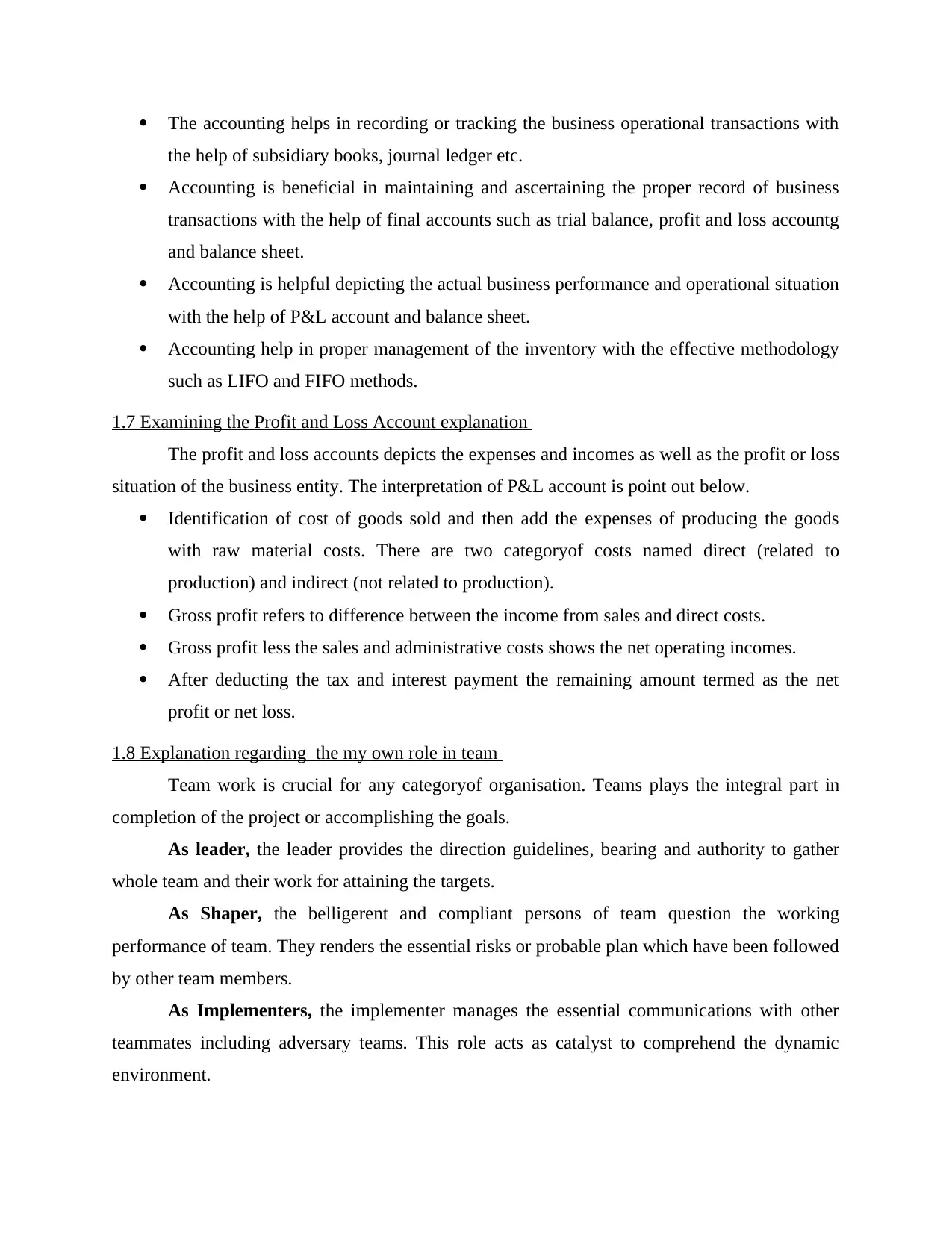
The accounting helps in recording or tracking the business operational transactions with
the help of subsidiary books, journal ledger etc.
Accounting is beneficial in maintaining and ascertaining the proper record of business
transactions with the help of final accounts such as trial balance, profit and loss accountg
and balance sheet.
Accounting is helpful depicting the actual business performance and operational situation
with the help of P&L account and balance sheet.
Accounting help in proper management of the inventory with the effective methodology
such as LIFO and FIFO methods.
1.7 Examining the Profit and Loss Account explanation
The profit and loss accounts depicts the expenses and incomes as well as the profit or loss
situation of the business entity. The interpretation of P&L account is point out below.
Identification of cost of goods sold and then add the expenses of producing the goods
with raw material costs. There are two categoryof costs named direct (related to
production) and indirect (not related to production).
Gross profit refers to difference between the income from sales and direct costs.
Gross profit less the sales and administrative costs shows the net operating incomes.
After deducting the tax and interest payment the remaining amount termed as the net
profit or net loss.
1.8 Explanation regarding the my own role in team
Team work is crucial for any categoryof organisation. Teams plays the integral part in
completion of the project or accomplishing the goals.
As leader, the leader provides the direction guidelines, bearing and authority to gather
whole team and their work for attaining the targets.
As Shaper, the belligerent and compliant persons of team question the working
performance of team. They renders the essential risks or probable plan which have been followed
by other team members.
As Implementers, the implementer manages the essential communications with other
teammates including adversary teams. This role acts as catalyst to comprehend the dynamic
environment.
the help of subsidiary books, journal ledger etc.
Accounting is beneficial in maintaining and ascertaining the proper record of business
transactions with the help of final accounts such as trial balance, profit and loss accountg
and balance sheet.
Accounting is helpful depicting the actual business performance and operational situation
with the help of P&L account and balance sheet.
Accounting help in proper management of the inventory with the effective methodology
such as LIFO and FIFO methods.
1.7 Examining the Profit and Loss Account explanation
The profit and loss accounts depicts the expenses and incomes as well as the profit or loss
situation of the business entity. The interpretation of P&L account is point out below.
Identification of cost of goods sold and then add the expenses of producing the goods
with raw material costs. There are two categoryof costs named direct (related to
production) and indirect (not related to production).
Gross profit refers to difference between the income from sales and direct costs.
Gross profit less the sales and administrative costs shows the net operating incomes.
After deducting the tax and interest payment the remaining amount termed as the net
profit or net loss.
1.8 Explanation regarding the my own role in team
Team work is crucial for any categoryof organisation. Teams plays the integral part in
completion of the project or accomplishing the goals.
As leader, the leader provides the direction guidelines, bearing and authority to gather
whole team and their work for attaining the targets.
As Shaper, the belligerent and compliant persons of team question the working
performance of team. They renders the essential risks or probable plan which have been followed
by other team members.
As Implementers, the implementer manages the essential communications with other
teammates including adversary teams. This role acts as catalyst to comprehend the dynamic
environment.
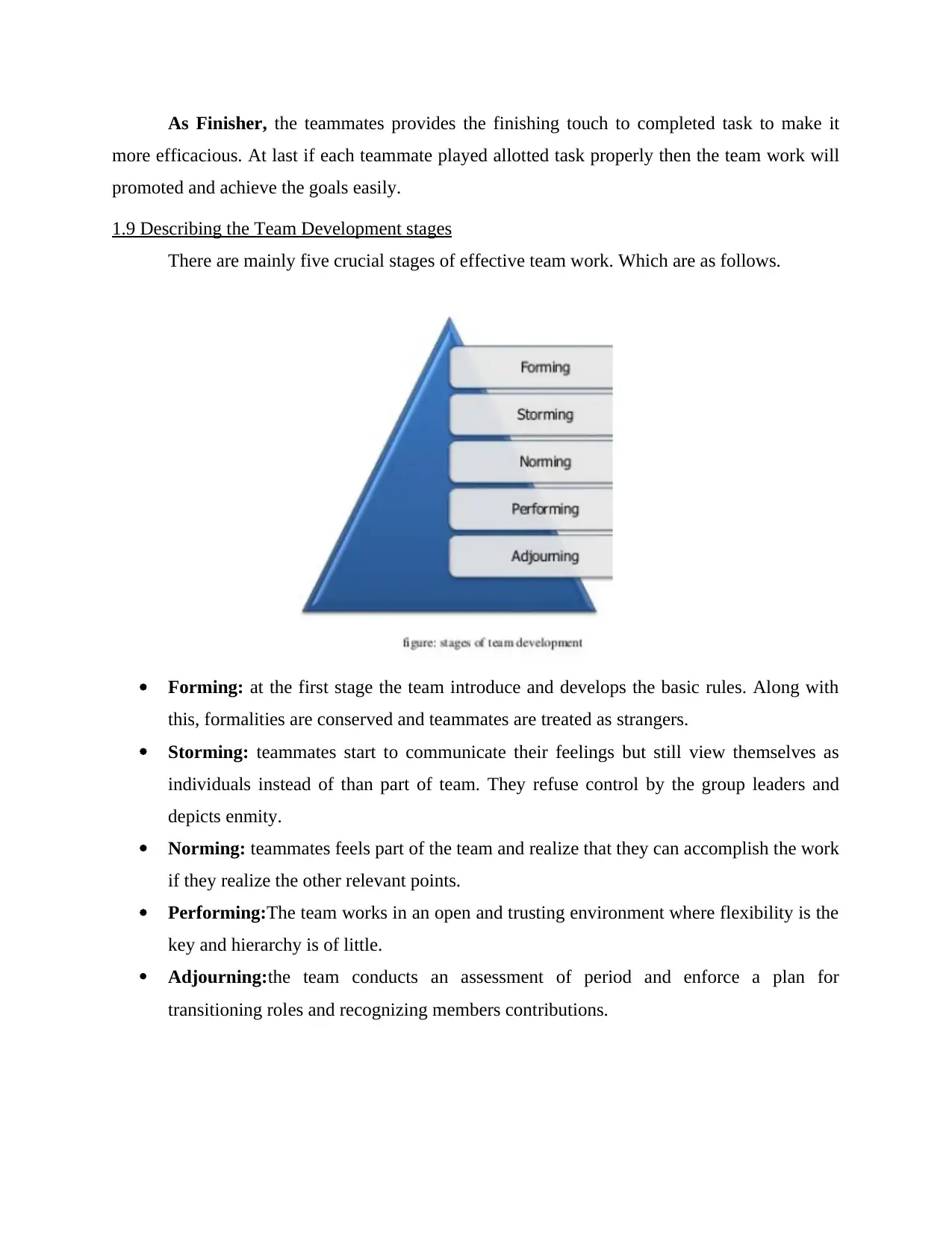
As Finisher, the teammates provides the finishing touch to completed task to make it
more efficacious. At last if each teammate played allotted task properly then the team work will
promoted and achieve the goals easily.
1.9 Describing the Team Development stages
There are mainly five crucial stages of effective team work. Which are as follows.
Forming: at the first stage the team introduce and develops the basic rules. Along with
this, formalities are conserved and teammates are treated as strangers.
Storming: teammates start to communicate their feelings but still view themselves as
individuals instead of than part of team. They refuse control by the group leaders and
depicts enmity.
Norming: teammates feels part of the team and realize that they can accomplish the work
if they realize the other relevant points.
Performing:The team works in an open and trusting environment where flexibility is the
key and hierarchy is of little.
Adjourning:the team conducts an assessment of period and enforce a plan for
transitioning roles and recognizing members contributions.
more efficacious. At last if each teammate played allotted task properly then the team work will
promoted and achieve the goals easily.
1.9 Describing the Team Development stages
There are mainly five crucial stages of effective team work. Which are as follows.
Forming: at the first stage the team introduce and develops the basic rules. Along with
this, formalities are conserved and teammates are treated as strangers.
Storming: teammates start to communicate their feelings but still view themselves as
individuals instead of than part of team. They refuse control by the group leaders and
depicts enmity.
Norming: teammates feels part of the team and realize that they can accomplish the work
if they realize the other relevant points.
Performing:The team works in an open and trusting environment where flexibility is the
key and hierarchy is of little.
Adjourning:the team conducts an assessment of period and enforce a plan for
transitioning roles and recognizing members contributions.
⊘ This is a preview!⊘
Do you want full access?
Subscribe today to unlock all pages.

Trusted by 1+ million students worldwide
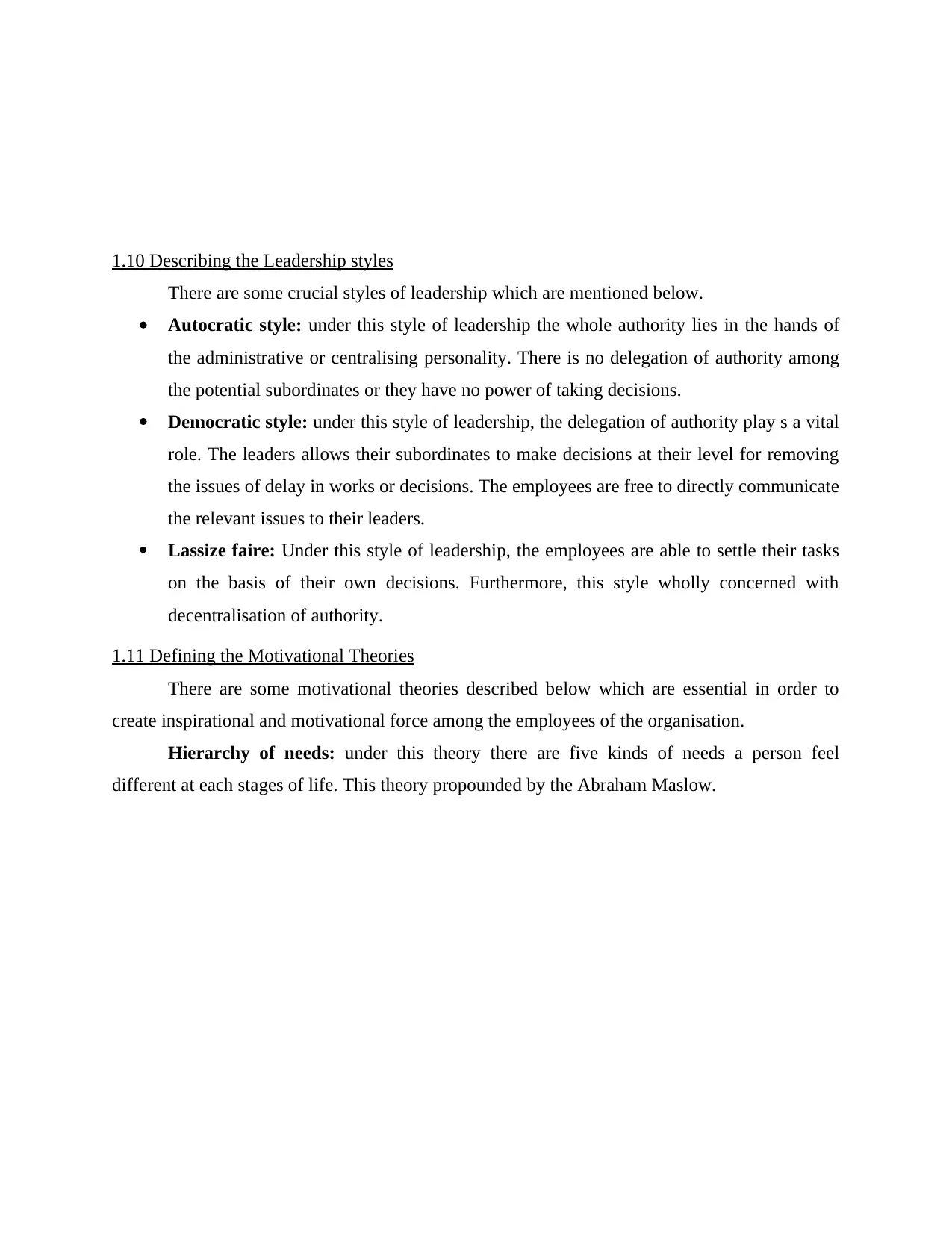
1.10 Describing the Leadership styles
There are some crucial styles of leadership which are mentioned below.
Autocratic style: under this style of leadership the whole authority lies in the hands of
the administrative or centralising personality. There is no delegation of authority among
the potential subordinates or they have no power of taking decisions.
Democratic style: under this style of leadership, the delegation of authority play s a vital
role. The leaders allows their subordinates to make decisions at their level for removing
the issues of delay in works or decisions. The employees are free to directly communicate
the relevant issues to their leaders.
Lassize faire: Under this style of leadership, the employees are able to settle their tasks
on the basis of their own decisions. Furthermore, this style wholly concerned with
decentralisation of authority.
1.11 Defining the Motivational Theories
There are some motivational theories described below which are essential in order to
create inspirational and motivational force among the employees of the organisation.
Hierarchy of needs: under this theory there are five kinds of needs a person feel
different at each stages of life. This theory propounded by the Abraham Maslow.
There are some crucial styles of leadership which are mentioned below.
Autocratic style: under this style of leadership the whole authority lies in the hands of
the administrative or centralising personality. There is no delegation of authority among
the potential subordinates or they have no power of taking decisions.
Democratic style: under this style of leadership, the delegation of authority play s a vital
role. The leaders allows their subordinates to make decisions at their level for removing
the issues of delay in works or decisions. The employees are free to directly communicate
the relevant issues to their leaders.
Lassize faire: Under this style of leadership, the employees are able to settle their tasks
on the basis of their own decisions. Furthermore, this style wholly concerned with
decentralisation of authority.
1.11 Defining the Motivational Theories
There are some motivational theories described below which are essential in order to
create inspirational and motivational force among the employees of the organisation.
Hierarchy of needs: under this theory there are five kinds of needs a person feel
different at each stages of life. This theory propounded by the Abraham Maslow.
Paraphrase This Document
Need a fresh take? Get an instant paraphrase of this document with our AI Paraphraser
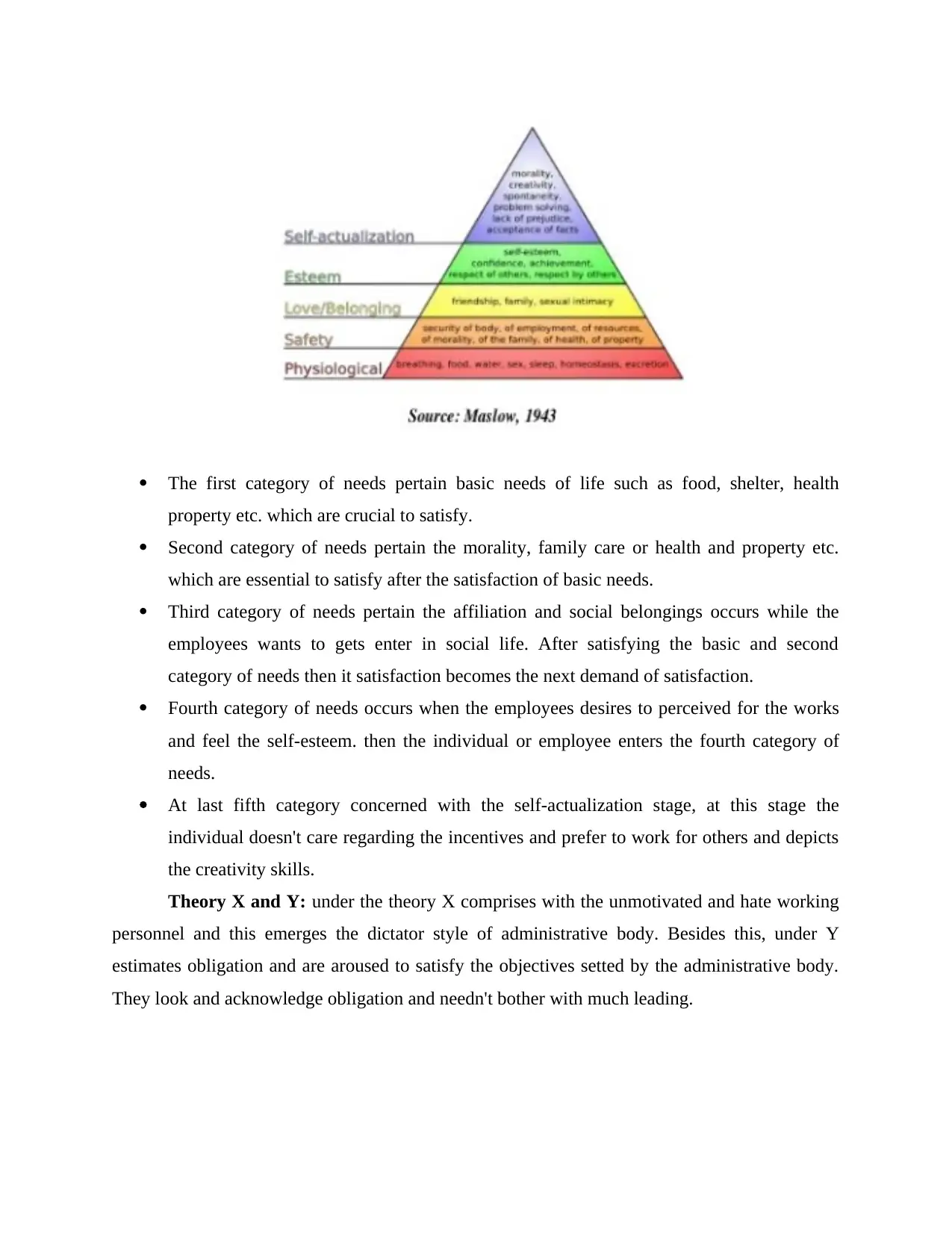
The first category of needs pertain basic needs of life such as food, shelter, health
property etc. which are crucial to satisfy.
Second category of needs pertain the morality, family care or health and property etc.
which are essential to satisfy after the satisfaction of basic needs.
Third category of needs pertain the affiliation and social belongings occurs while the
employees wants to gets enter in social life. After satisfying the basic and second
category of needs then it satisfaction becomes the next demand of satisfaction.
Fourth category of needs occurs when the employees desires to perceived for the works
and feel the self-esteem. then the individual or employee enters the fourth category of
needs.
At last fifth category concerned with the self-actualization stage, at this stage the
individual doesn't care regarding the incentives and prefer to work for others and depicts
the creativity skills.
Theory X and Y: under the theory X comprises with the unmotivated and hate working
personnel and this emerges the dictator style of administrative body. Besides this, under Y
estimates obligation and are aroused to satisfy the objectives setted by the administrative body.
They look and acknowledge obligation and needn't bother with much leading.
property etc. which are crucial to satisfy.
Second category of needs pertain the morality, family care or health and property etc.
which are essential to satisfy after the satisfaction of basic needs.
Third category of needs pertain the affiliation and social belongings occurs while the
employees wants to gets enter in social life. After satisfying the basic and second
category of needs then it satisfaction becomes the next demand of satisfaction.
Fourth category of needs occurs when the employees desires to perceived for the works
and feel the self-esteem. then the individual or employee enters the fourth category of
needs.
At last fifth category concerned with the self-actualization stage, at this stage the
individual doesn't care regarding the incentives and prefer to work for others and depicts
the creativity skills.
Theory X and Y: under the theory X comprises with the unmotivated and hate working
personnel and this emerges the dictator style of administrative body. Besides this, under Y
estimates obligation and are aroused to satisfy the objectives setted by the administrative body.
They look and acknowledge obligation and needn't bother with much leading.
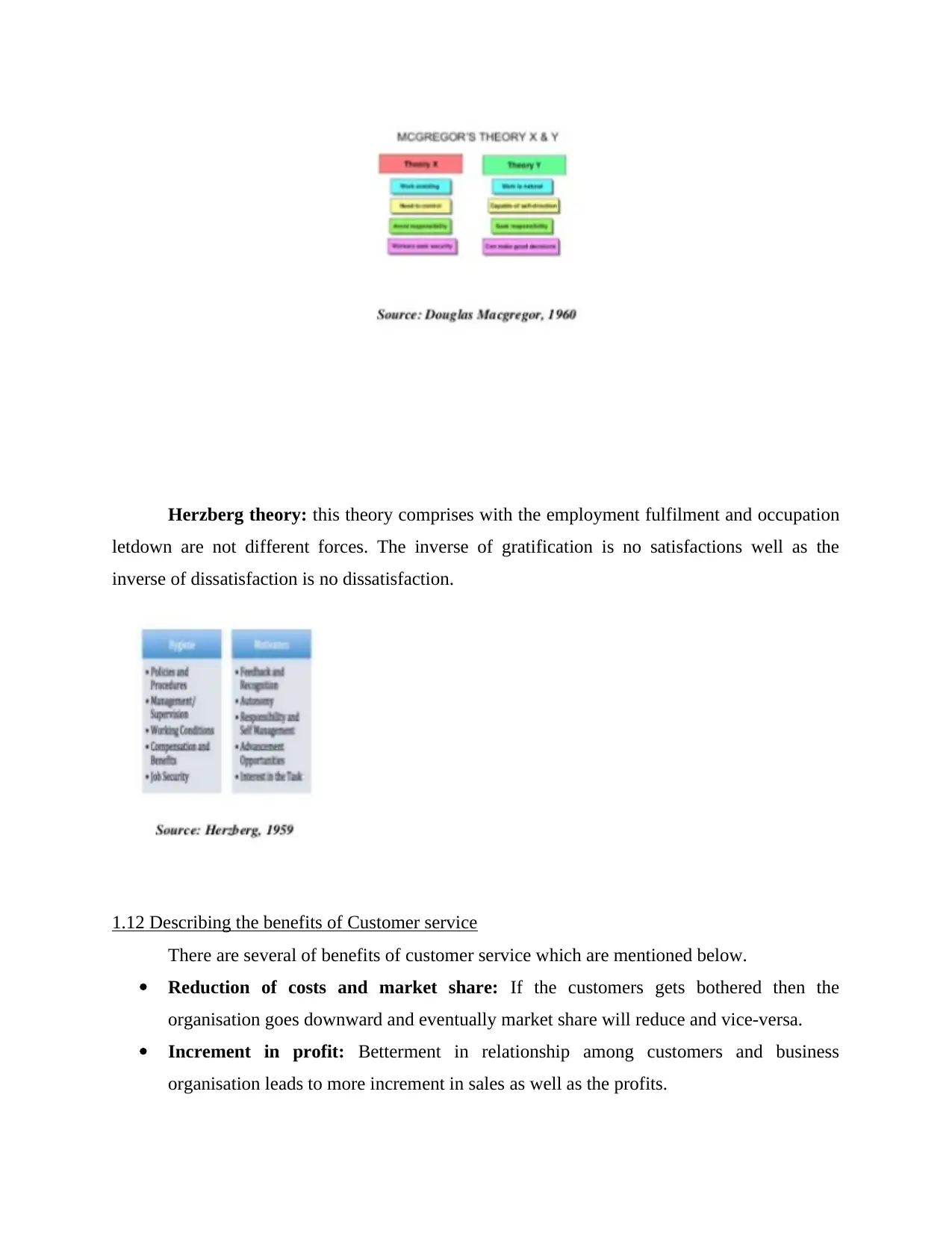
Herzberg theory: this theory comprises with the employment fulfilment and occupation
letdown are not different forces. The inverse of gratification is no satisfactions well as the
inverse of dissatisfaction is no dissatisfaction.
1.12 Describing the benefits of Customer service
There are several of benefits of customer service which are mentioned below.
Reduction of costs and market share: If the customers gets bothered then the
organisation goes downward and eventually market share will reduce and vice-versa.
Increment in profit: Betterment in relationship among customers and business
organisation leads to more increment in sales as well as the profits.
letdown are not different forces. The inverse of gratification is no satisfactions well as the
inverse of dissatisfaction is no dissatisfaction.
1.12 Describing the benefits of Customer service
There are several of benefits of customer service which are mentioned below.
Reduction of costs and market share: If the customers gets bothered then the
organisation goes downward and eventually market share will reduce and vice-versa.
Increment in profit: Betterment in relationship among customers and business
organisation leads to more increment in sales as well as the profits.
⊘ This is a preview!⊘
Do you want full access?
Subscribe today to unlock all pages.

Trusted by 1+ million students worldwide
1 out of 16
Related Documents
Your All-in-One AI-Powered Toolkit for Academic Success.
+13062052269
info@desklib.com
Available 24*7 on WhatsApp / Email
![[object Object]](/_next/static/media/star-bottom.7253800d.svg)
Unlock your academic potential
Copyright © 2020–2025 A2Z Services. All Rights Reserved. Developed and managed by ZUCOL.




